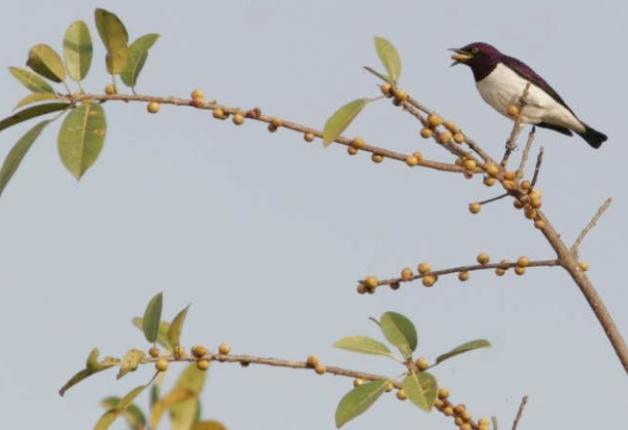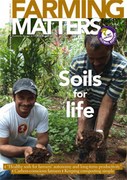Farmers worldwide know that their choice of practices is key to the health of their soils. And this, in turn, is key to producing healthy food. But healthy soils, in many cases, are not the norm and so farmers must restore degraded lands. Here we see four different examples that offer a range of practical techniques that are successfully building healthier soils.
Iran: Better soil, and better tasting food
In northern Iran, rice farming follows the green revolution, using various pesticides, fertilizers, and high yielding crop varieties. Drastic changes to this well-set system have not been possible, so, on our family farm we started a step-wise approach, introducing novel practices one by one, and firstly on a small part of our land, increasing the area and attracting more interest as the years went by.
With roots in agricultural management and environmental activism, we were motivated to try and influence more people to question the increasingly industrial food system and how this is related to the way we farm. Firstly we introduced Trichogramma wasps as natural enemies of the stem borer pest, to good effect. Following a reduction in pesticide use, next we cut the use of chemical fertilizers.
Using organic fertilizers also increased pest resistance and improved crop quality, and small reductions in crop yields proved only temporary. We tried wood-based and tea-based composts too, and ploughed in rice straw and husks, leading to improved soil structure, and crop yields – on average a tonne per hectare higher than before. Our customers are also very satisfied, saying that our rice and all our other crops taste better, and we are seeing a growing demand for our special rice. The successes we have seen, and shown to others, are now promoting the scaling up of these approaches over larger areas.
For more information, contact Soroush Marzban, a family farmer and student of farm machinery engineering and agricultural management.
Email: soroush.marzban@gmail.com
India: Carbon capturing with the ‘Saguna Rice Technique’
Saguna Baug is an inspiring story of transformation of 20 hectares of highly degraded ancestral land in Maharastra, India into a productive farm with cereal crops, multipurpose trees, livestock and aquatic fauna. It is also a story on how perseverance can fuel innovation to reverse the growth decline in agriculture by innovating appropriate practices to enrich soil with organic carbon.
Early attempts by the farmer Chandrashekhar Bhadsavle failed, until he invested in three hectares of ponds. These yield 8 tonnes of fish and 10 truckloads of bamboo every year and attract much beneficial wildlife, besides being an essential reserve of irrigation water. But most importantly, has been the Saguna Rice Technique, sowing 3-4 seeds every 25 cm on permanent raised beds with no ploughing, puddling or transplanting, reducing erosion, improving soil quality, and 30-40% less labour is needed.
Zero tillage is followed religiously, with the roots of the previous crop preventing the soil from cracking, adds organic carbon to the soil, and improves moisture holding capacity, reducing ‘water footprints’ of the next crop by as much as 40-50%. Rice matures earlier too, and two crops can be taken in a year, and the Regional Agriculture Research Station in Karjat is now conducting field trials using the technique.
Fore more information, contact Sudhirendar Sharma. Sudhirendar works at The Ecological Foundation in New Delhi, India and researches and writes on agriculture and related development issues.
Email: sudhirendarsharma@gmail.com
Egypt: Sand + waste = Fertile soil
The ancient agricultural system of the Nile valley is now plagued by excessive use of chemical fertilizers, outdated and harmful pesticides, and inadequate tenure regulations. Family farming is rapidly disappearing, with high costs of leasing land and buying inputs, and a fluctuating water supply, and ever more people migrate to Cairo. Then, enter Mrs Rawya Mansour. With no farming experience, she decided to try and help farming communities by trying ways to use agricultural waste and produce organic soil amendments and biogas. Her farm has attracted local youth who learn how to make compost from rice straw, chicken manure, and other readily available ingredients, and with addition of biochar, this biofertilizer turned the sandy desert soil into highly fertile farmland with little need for chemical fertilizer.
Mrs Mansour’s soil also holds more water, helped by mulching, with rice straw also suppressing weed growth and absorbing salts from the soil. Farmers saw the yield increases and the better tasting vegetables, and they started making compost in their own farms, and mixing with biochar. Mrs Mansour’s innovations and energy is converted into the spread of agroecological practices, and helping to liberate farmers from a dependency on chemical inputs.
For more information, contact Tarek Soliman. Tarek has a Masters in agroecology, is a freelance consultant on sustainable food production and works with civil society organisations on the right to food.
Email: sudhirendarsharma@gmail.com
Nigeria: ‘Super vegetable gardens’ from biochar
Using charcoal to improve soil fertility is an age-old practice, but scientists are now re-discovering its value. A single application of 5-20 tonnes per hectare can double crop yields and provide long-lasting benefits by activating soil microorganisms and increasing water retention capacity. In north central Nigeria, land degradation is extreme, with nutrients removed by constant cultivation not replenished.
In 2011, Pro-Natura and the A. P. Leventis Ornithological Research Institute together started work with communities in Lamingo on the Jos plateau, and has demonstrated the effectiveness of biochar on increasing yields and food security, with greatest benefits when incorporated into sustainable agroecological systems alongside a host of other techniques enhancing biodiversity and enriching soil organic matter.
A hundred farming families now reap the rewards from their highly productive biocharenriched ‘super vegetable gardens’, built from kits, along with a suite of complementary innovations. Imported kits are good as pilots, but components may be readily substituted with local materials.
Farmers have shown great interest, and besides learning about biochar, they are also trained in tree propagation, landscape ecology, and planting shelterbelts and living fences. In the words of Al Gore, former US Vice President, the use of biochar is “One of the most exciting new strategies for restoring carbon to depleted soils, and sequestering significant amounts of carbon dioxide for a thousand years and more.”
For more information, contact Wilfrid Pineau (wilfrid.pineau@wanadoo.fr), an agronomist at Pro-Natura International; Rahila Meriba (rahila.meriba@yahoo.com), a project coordinator at the A. P. Leventis Ornithological Research Institute, University of Jos, Nigeria and; Petra Bakewell-Stone (petra@acamedia.org).


